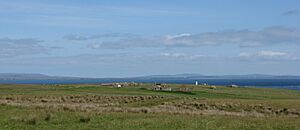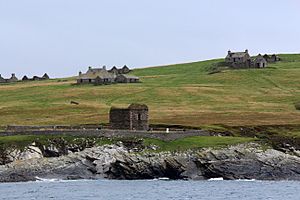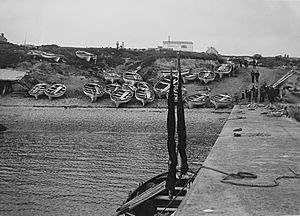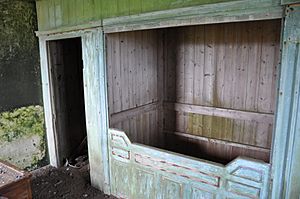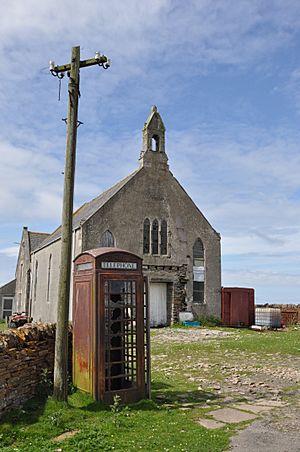Island of Stroma facts for kids
| Norse name | Straumøy or Straumsey |
|---|---|
| Meaning of name | Island in the stream |
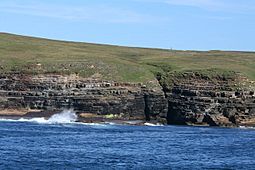 Geo, on west of Stroma |
|
| OS grid reference | ND 35105 77539 |
| Coordinates | 58°40′48″N 3°07′12″W / 58.680°N 3.120°W |
| Physical geography | |
| Area | 375 ha (930 acres) |
| Area rank | 78= |
| Highest elevation | Cairn Hill 53 m (174 ft) |
| Administration | |
| Sovereign state | United Kingdom |
| Country | Scotland |
| Council area | Highland |
| Demographics | |
| Population | 0 |
The Island of Stroma, also called Isle of Stroma or simply Stroma, is an island located off the northern coast of Scotland. It's just north of John o' Groats. Stroma is the most southerly island in the Pentland Firth, a busy stretch of water between the Orkney islands and the mainland area of Caithness. The name "Stroma" comes from an old Norse word, Straumr-øy, which means "island in the tidal stream." This name perfectly describes the strong currents around the island.
Ancient stone structures show that people lived on Stroma a very long time ago. Around 900 to 1,000 years ago, Norse people (Vikings) were also present, as mentioned in the Orkneyinga Saga, an old Viking story. Stroma has been connected to Caithness since at least the 1400s. Even though the island is only a few miles from the Scottish coast, the wild weather and very strong tides of the Pentland Firth made life on Stroma very isolated. This meant the islanders had to be mostly self-sufficient, growing their own food and catching fish. They would trade these with people on the mainland.
Most islanders were fishermen and crofters (small-scale farmers). Some also worked as pilots, guiding ships safely through the dangerous waters of the Pentland Firth. Shipwrecks were common because of the strong tides and currents. The most recent one happened in 1993. Finding things from shipwrecks was an extra way for islanders to earn money, though it was often against the law. A lighthouse was built on Stroma in 1890 and still works automatically today.
Stroma is now empty, with the old houses of its former residents falling apart. The number of people living there slowly dropped through the first half of the 1900s. People left to find better opportunities elsewhere, as money problems and Stroma's isolation made life on the island too hard. From a high point of 375 people in 1901, the population fell to just 12 by 1961. The last islanders left at the end of 1962. Stroma became completely empty in 1997 when the lighthouse keepers and their families moved away. The island is now owned by one of its former residents, who uses it to graze sheep.
Contents
Geography and Nature
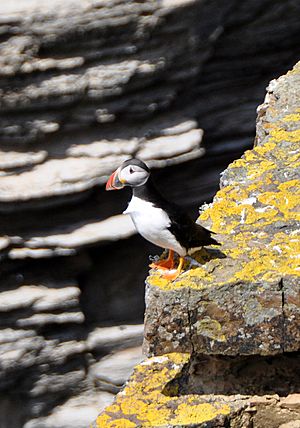
Stroma is located in the Pentland Firth, about 2 miles (3 km) northwest of John o' Groats on the mainland. The island splits the firth into two channels: the Inner Sound to the south and the Outer Sound to the north. Stroma is mostly flat and low-lying, covering an area of about 375 hectares (927 acres). Its highest point is Cairn Hill in the southeast, which is 53 meters (174 ft) high. The island runs north to south, measuring about 2 miles (3 km) long and 1 mile (1.6 km) wide.
The island is surrounded by cliffs that are about 33 meters (108 ft) high on the west coast. Elsewhere, the cliffs are lower with a narrow rocky shore. The eastern side of the island slopes downwards. The rocks of the island are made of flat layers of old sandstone, called Rousay flags. This fine-grained stone was once quarried (mined) in small amounts for use as roofing material on the mainland.
Stroma has many inlets called geos. These are created by waves wearing away the sea cliffs along natural cracks in the rock. A partially collapsed sea cave called The Gloup is in the northwest of the island. This is a deep rocky pit filled with seawater. It connects to the sea through a hidden passage 165 yards (151 m) long. People used to say this passage was used for secret trading, hiding illegal goods in a cave inside The Gloup that could only be reached at low tide.
The plants and animals on Stroma are similar to those on the mainland. The island has no trees; its plants are mostly grasses, heather, and small flowers. Seals are common along the shores and sometimes go inland during the breeding season. Both grey seals and harbour seals live here, with about 650 grey seal pups born each year. Otters might also be present. The western cliffs are home to many seabirds like terns, guillemots, fulmars, and eider ducks. These cliffs are a special protected area for nature. The waters around Stroma also have different types of whales and dolphins, including minke whales, white-beaked dolphins, and harbour porpoises.
Island Population
Two main settlements were on Stroma: Nethertown in the north and Uppertown (or Overtown) in the south. Between them was Mains of Stroma, the island's main farm. A track runs the whole length of the island, connecting the lighthouse at the north end with the two settlements and the harbor on the south coast.
The island is now empty of people. The last islanders who lived there all the time left in 1962. The very last people, the lighthouse keepers and their families, left in 1997 when the lighthouse became automatic. The population reached its highest point of 375 people in 1901. Census records from 1841 to 1961 show how Stroma's population dropped during the 1900s:
| Year | 1841 | 1851 | 1861 | 1871 | 1881 | 1891 | 1901 | 1911 | 1921 | 1931 | 1951 | 1961 |
|---|---|---|---|---|---|---|---|---|---|---|---|---|
| Population | 186 | 211 | 291 | 330 | 341 | 327 | 375 | 339 | 277 | 193 | 111 | 12 |
Island History
Early Settlements
Stroma was home to people in ancient times. This is known because of several old stone structures found around the island. A ruined stone burial mound is near the lighthouse at the far north end of the island. It has been partly dug up and is about 16 meters (52 ft) wide and 1.8 meters (6 ft) high. In the 1700s, islanders collected old stone arrowheads they found, believing them to be "elf-shot" made by fairies. They thought owning an "elf-shot" would protect them and their animals from harm by fairies.
Structures similar to stone coffins, which the islanders called "Picts' Beds," are also on the island. They are usually found near old rubbish heaps where animal bones and shells are visible. Not much is known about why these structures were built or where they came from.
Medieval Times
The first written record of Stroma is in the 12th-century Orkneyinga Saga. It tells of a man named Valthiof who lived and farmed on Stroma. One Christmas Eve, he sailed to Orkney but his boat was lost. The Saga says this was "sad news as Valthiof was a most accomplished man." Later, a famous Viking named Sweyn Asleifsson hid on Stroma from Earl Harald Haakonsson. The two were stuck on the island due to bad weather but were convinced to make peace.
The Norse people are also believed to have built a fort, now called Castle Mestag, in the far southwest of Stroma. This structure is on top of a tall, isolated rock pillar about 4.5 meters (15 ft) from the main island's cliffs. Islanders thought it was once connected by a bridge, or perhaps a rock arch that has since fallen down.
Because Stroma is so close to the Scottish mainland, it has long been politically connected with Caithness. An old story says that the Earls of Orkney and Caithness once argued over who owned the island. To settle it, they used a legend that poisonous animals would live in Caithness but die in Orkney. Some poisonous snakes were brought to Stroma and survived, "proving" the island belonged to Caithness.
It is known that in 1455, the Bishop of Caithness gave Stroma to his brother Gilbert. The island later came into the hands of the Clan Sinclair family, who have been the Earls of Caithness since 1455.
Life on Stroma: 1600s and 1700s
Life on Stroma was very isolated because it was hard to reach. Until 1894, there was no proper place for boats to land. Boats had to be pulled directly onto the beach. Especially in winter, when storms raged through the Pentland Firth, Stroma could be cut off for weeks. This was dangerous for the islanders, as they had no doctor. In the winter of 1937, the island was cut off for three weeks by strong gales. Most people caught the flu, and food supplies ran low. Eventually, two boats reached the island with supplies, a doctor, and three weeks' worth of mail.
Two small churches were built on Stroma before the 1600s. Their exact locations are now unknown. They were no longer used by the mid-1600s. Without their own church, islanders were seen by mainlanders as not very religious. The minister from Canisbay on the mainland was supposed to visit Stroma four times a year but often only came twice. Islanders were told to attend church in Canisbay, and those with boats who didn't go were fined.
The island's population was a few dozen families throughout the 1700s, meaning a couple of hundred people. They rented their land from two branches of the Sinclair family. The island was quite profitable for the Sinclairs. In 1724, islanders paid rent, partly in extra grain that Stroma's boats took to the Sinclair storage buildings. They also produced their own dairy products and were known for their good cheese.
1800s and 1900s
By the early 1800s, about 30 families (170 people) lived on Stroma, farming land using an old system called run rig. The island was known for growing a lot of corn. Islanders didn't use plows but dug high beds, which produced more crops. Farming life was typical for small farms, with an average Stroma farm being about 10 acres (4 hectares). Families usually had a few cows, sheep, and chickens, plus a horse and a pig. They grew oats, potatoes, hay, and turnips. They got water from wells and used horses for transport. They also sold flagstones from the island and brought in peat for fuel.
Islanders also supported themselves by fishing. The waters around Stroma had excellent fish, especially cod. People said the cod had the firmest white meat because they had to swim in strong currents all the time. Islanders also caught lobsters. The island was known for its special type of boat, the Stroma yole, which was like an old Norse longship.
Many of the men used their knowledge of the Firth's currents to guide passing ships as maritime pilots. Their skill came from a lifetime of experience on the water. Stroma was always wet from the sea spray thrown up by the powerful tides and storms, especially in winter. Islanders used this by collecting the water in a reservoir to power a watermill that ground their grain in winter.
Stroma's strong storms sometimes caused damage. In December 1862, a huge storm swept across the northern end of Stroma, leaving rocks and seaweed on top of the 100-foot-high cliffs. However, the sea's power also had a benefit: shipwrecks. Over the last 200 years, more than 60 ships have been wrecked on Stroma's shores. Shipwrecks were a valuable source of income, wood, and goods for the islanders, who would often take things from abandoned ships, sometimes illegally. Some islanders were against building Stroma's first lighthouse because they made money from shipwrecks.
Shipwrecks continued, with one of the most profitable being the 1931 wreck of the Danish ship Pennsylvania. Islanders from Stroma and nearby islands took many items from its cargo, including slot machines, spark plugs, clothes, tobacco, watches, and car parts. These were hidden in haystacks, fields, and caves. Customs officers and police were not usually welcome on the island, which had no police force. Islanders made it clear that bad things could happen to the boats of unwanted visitors. Even today, the area is dangerous for ships. In 1993, the Danish ship Bettina Danica ran aground off Stroma. Only its back section is still visible.
Another way islanders made money was by secretly making alcohol. An inspector in 1824 said Stroma's people were "all professed smugglers." When authorities stopped smuggling, the island's population dropped in the early 1800s. But secret alcohol making continued for many years.
Despite being physically isolated, the islanders had a lively community. A school was started in 1723. Many children helped their families in summer and only attended school in winter. Two churches were built in the late 1800s, a Baptist chapel and a Church of Scotland church.
Stroma's inhabitants were very self-sufficient. Many had extra skills like carpentry or roof-laying, besides fishing or farming. They built their own houses and boats, grew most of their food, fixed farm equipment, and made their own clothes and shoes. In the 1920s, they even built their own wind turbines to power their radios. By the late 1800s, the island had three shops, including a grocery. They bought other things from shops on the mainland or through mail-order catalogs. For a while, a floating shop would come from Orkney. Customers would row out to buy groceries and other goods, trading them for lobsters, salted fish, and eggs.
Most houses on Stroma were single-story stone buildings with two main rooms and a small bedroom and porch. The rooms were small and simply furnished. One former islander, Jimmy Simpson, remembered that "we had about two hundred and fifty folks here when I was a boy. It never seemed a lonely place. There were always people going in and out of each other's houses, there were forty children at the school and there were two teachers." He also said that Stroma women were very hardworking, managing the farms while the men were away fishing.
Decline and Abandonment
Stroma's population dropped quickly through the first half of the 1900s, leading to the island being completely abandoned by the late 1950s. There wasn't one single reason for this. Life on the island was always basic; there was no running water or electricity, and gas only arrived in the 1950s. This was very different from improvements happening on the mainland. Fishing became harder after the First World War, and farming became less profitable. The island was also quite crowded for its size, and there wasn't enough land for everyone to farm. Families often had six to eight children, but not enough work for all of them, so the oldest often left for the mainland or moved to other countries to find jobs. The lack of a proper harbor meant islanders couldn't use bigger boats or have a modern fishing industry. Young people started leaving for better opportunities, and their parents eventually followed.
Both World Wars greatly affected Stroma. Six islanders died in each war. During the Second World War, about a quarter of the population was serving in the military. Adding to the island's problems, a new school exam in 1944 meant that all children over 12 had to leave Stroma to go to secondary school in Wick. They had to live away from home, which cost their parents extra money.
Two other things are often mentioned for Stroma's depopulation: the building of the nuclear power station at nearby Dounreay in the 1950s, which created many new jobs on the mainland, and the building of a harbor on Stroma in the same decade, which employed many islanders. While some say these gave islanders a reason to leave, most islanders who left after 1945 didn't go directly to Dounreay. They continued fishing or farming on the mainland, or found other jobs.
The Sinclair family sold their part of the island in 1929. The new owner, John Hoyland, bought the rest of the island in 1947. His time as owner saw the final collapse of the island's population. As people left, Hoyland tried to sell Stroma but found no buyers. The local council also rejected ideas for taking over the island. As the population left, the local economy fell apart. There weren't enough people to man fishing boats, and the remaining shops closed. The last store on the island closed in 1956. By 1957, only three families (16 people) were left. That year, the island's school closed with only two students. The Post Office closed in 1958 when the family running it left.
In 1958, Hoyland caused a stir by offering the island as a prize on an American TV quiz show. After many complaints, the show offered a car instead. In December 1960, he sold Stroma to Jimmy Simpson, an islander whose family had moved to the mainland in 1943. Simpson bought the island to graze his animals, bringing about 200 sheep and 30 cattle. The Simpson family still uses the island for sheep grazing today.
By this time, the Manson family was the last native family living on Stroma. The head of the family, Andrew Manson, called the island "a paradise in summer" and a place where he was "free of outside distractions." But it was a hard life for the women. The Mansons finally left Stroma on December 6, 1962, ending thousands of years of people living permanently on the island.
Island of Ruins
Stroma is now completely empty of people. Its only permanent residents are seals, birds, and sheep. The church, school, and old farmhouses are abandoned, with many falling apart. A writer named Bella Bathurst visited the island and described how some houses still have their windows and roofs, looking better than others. In some, furniture is still arranged as if people just left: iron beds, tables, and cupboards. But most houses have lost the battle with the weather. Once the roof tiles are gone, dampness gets in, and within a few years, only the bare walls are left.
Inside some houses, everyday objects are still where they were left decades ago. In one house, the bed and ceiling are still intact. The kitchen table is in the living room, and a faded photograph is on the fireplace mantel. Another writer, Leslie Thomas, saw family photos in a ruined house 20 years earlier, showing a once warm family life.
In the abandoned school, books are still "dusty but tidy." The church still has its pulpit, with prayer books left to be walked on by sheep and nibbled by rabbits. In the old post office, forms, license applications, and a bottle of dried ink are still on the counter. In a back room, there's a dresser with a teapot, a jug, and sheet music.
Writers have different feelings about Stroma's abandonment. Thomas sees it as a sad event. But Bathurst thinks it's not just sad. She says, "What is interesting about Stroma is not the fact of its abandonment, but the tale of its past."
Recently, a company called MeyGen Ltd installed four huge tidal turbines on the ocean floor near Stroma. In 2019, these turbines produced enough electricity to power 4,000 homes.
Communications
Stroma didn't have a regular connection to the mainland until 1879. That's when the Post Office started a weekly boat service and opened a post office on the island. However, very little mail came from Stroma, so the service was very expensive for the Post Office.
For many years, islanders had no way to contact the mainland in emergencies except by signaling with lamps and hoping someone would see them. A radio telephone was installed in 1935, and in 1953, a telephone cable was laid. A red telephone box was put in the center of the island. It was special because it was the 6 millionth phone box installed in the UK. It's still there today, but it doesn't work anymore.
It wasn't until 1894 that Stroma got its first man-made landing spot, a pier built near Nethertown. In 1955, the local council built a new harbor on the south coast of the island. Even though it was meant to stop people from leaving, Stroma was abandoned only a few years after the harbor was finished.
In the late 1930s, Highland Airways looked into including Stroma in its ambulance plane service. In 1937, a small plane landed in a field on Stroma. The next spring, islanders cleared an area to create an airstrip. The first official flight landed in June 1938. However, the Second World War stopped any further plans, and a regular service was never started.
Today, Stroma has no regular connections to the mainland. The island's owner used to run occasional boat trips for visitors, including Prince Charles, who painted pictures of the abandoned houses.
Important Buildings
Lighthouse
| Location | Stroma Island 2 mi (3 km) north of Gills Bay Caithness Scotland United Kingdom |
|---|---|
| Coordinates | 58°41′45.2″N 03°07′00.1″W / 58.695889°N 3.116694°W |
| Year first constructed | 1890 |
| Automated | 1997 |
| Construction | masonry tower |
| Tower shape | cylindrical tower with balcony and lantern attached to 1-storey keeper's house |
| Markings / pattern | white tower, black lantern, ochre trim |
| Height | 23 m (75 ft) |
| Focal height | 32 m (105 ft) |
| Range | 26 nmi (48 km) |
| Characteristic | Fl (2) W 20s. |
In 1890, a lighthouse was built at Stroma's northern tip. It only worked for six years before being replaced. The original lighthouse used a special lamp that burned petroleum spirit. Local fishermen or farmers had to refuel it regularly.
It was replaced in 1896 by a new lighthouse designed by David Stevenson. A fog warning system was added the next year. Stevenson's lighthouse is a round, white stone tower, 23 meters (75 ft) high. It stands 32 meters (105 ft) above the high water mark. There are also buildings nearby for generators and the lighthouse keepers. The light was changed to a paraffin lamp. The lighthouse was attacked by a German aircraft in 1941 but was not badly damaged.
Until 1961, the lighthouse was managed as a station with keepers living nearby. After the islanders left, it became a "rock station." An electric lamp was installed in 1972. By this time, the keepers and their families were the only people living on Stroma. A helicopter pad was built to bring in supplies and staff. In 1997, the lighthouse became automatic. It now uses a 250-watt lamp that rotates. The old fog horn was replaced with an electric one. The lighthouse's power now comes from batteries that are charged regularly. The light flashes white every 20 seconds and can be seen from about 26 nautical miles (48 km) away.
Kennedy Mausoleum
The Kennedy mausoleum is a burial place on the island. It's part of the island's history, connected to the Kennedy family who once had ties to Stroma.
Images for kids
See also
 In Spanish: Isla de Stroma para niños
In Spanish: Isla de Stroma para niños


